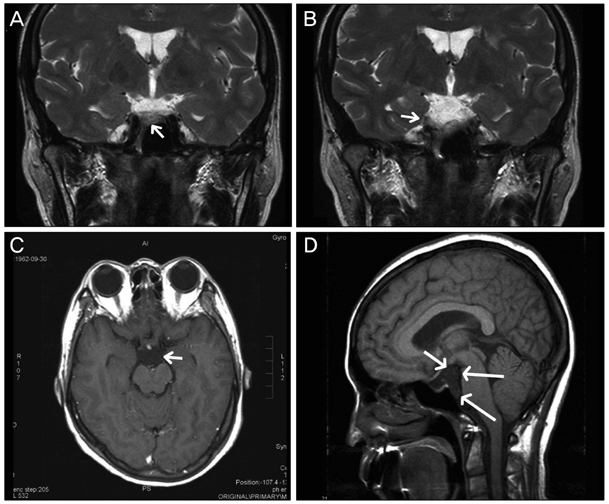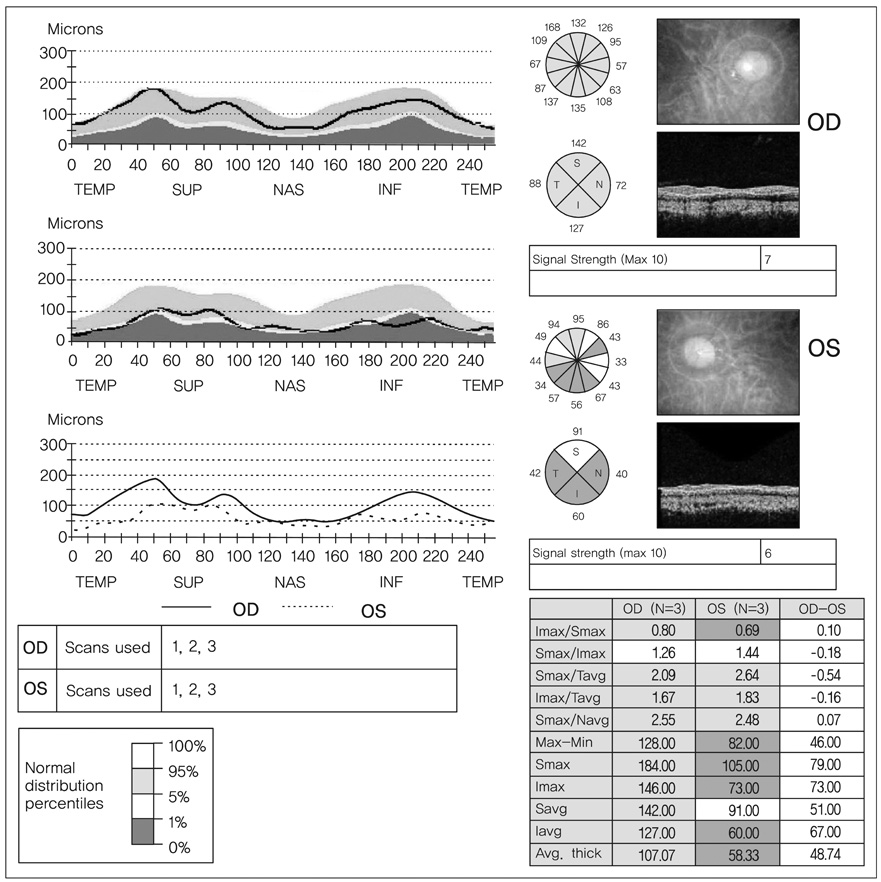Korean J Ophthalmol.
2010 Aug;24(4):256-259. 10.3341/kjo.2010.24.4.256.
Optic Neuropathy Associated with Castleman Disease
- Affiliations
-
- 1Department of Ophthalmology, Kim's Eye Hospital, Konyang University College of Medicine, Seoul, Korea.
- 2Department of Ophthalmology, Seoul National University Bundang Hospital, Seoul National University College of Medicine, Seongnam, Korea. hjm@snu.ac.kr
- KMID: 949067
- DOI: http://doi.org/10.3341/kjo.2010.24.4.256
Abstract
- A 44-year-old woman with Castleman disease presented with acute visual loss in the left eye. A full ophthalmologic examination and imaging were performed. Visual acuity was 20/20 in the right eye and 20/100 in the left eye. Total dyschromatopsia, a relative afferent pupillary defect, and a cecocentral scotoma were observed in the left eye. Mild disc edema, without leaking during fluorescein angiography, was also observed. Magnetic resonance imaging revealed a small cystic epidermoid-like lesion in the right prepontine and suprasellar cistern. Her visual acuity did not improve and deteriorated to 20/200 in the left eye at 22 months after the initial visual loss. Optic neuropathy may rarely be associated with Castleman disease and suggests a poor prognosis.
MeSH Terms
-
Adult
Diagnosis, Differential
Disease Progression
Female
Fluorescein Angiography
Fundus Oculi
Giant Lymph Node Hyperplasia/*complications/diagnosis
Humans
Magnetic Resonance Imaging
Optic Nerve Diseases/diagnosis/*etiology/physiopathology
Tomography, Optical Coherence
Visual Acuity
Visual Field Tests
Visual Fields
Figure
Cited by 1 articles
-
Scleritis in a Patient with Castleman Disease
Jae Jung Lee, In Ho Lee, Kang Yeun Park, Sung Who Park, Ji Eun Lee
J Korean Ophthalmol Soc. 2018;59(8):785-789. doi: 10.3341/jkos.2018.59.8.785.
Reference
-
1. Waterston A, Bower M. Fifty years of multicentric Castleman's disease. Acta Oncol. 2004. 43:698–704.2. Casper C. The aetiology and management of Castleman disease at 50 years: translating pathophysiology to patient care. Br J Haematol. 2005. 129:3–17.3. Kepes JJ, Chen WY, Connors MH, et al. "Chordoid" meningeal tumors in young individuals with peritumoral lymphoplasmacellular infiltrates causing systemic manifestations of the Castleman syndrome: a report of seven cases. Cancer. 1988. 62:391–406.4. Severson GS, Harrington DS, Weisenburger DD, et al. Castleman's disease of the leptomeninges: report of three cases. J Neurosurg. 1988. 69:283–286.5. Beck JT, Hsu SM, Wijdenes J, et al. Brief report: alleviation of systemic manifestations of Castleman's disease by monoclonal anti-interleukin-6 antibody. N Engl J Med. 1994. 330:602–605.6. Ishiyama T, Koike M, Nakamura S, et al. Interleukin-6 receptor expression in the peripheral B cells of patients with multicentric Castleman's disease. Ann Hematol. 1996. 73:179–182.7. Deckert-Schluter M, Schluter D, Schwendemann G. Evaluation of IL-2, sIL2R, IL-6, TNF-alpha, and IL-1 beta levels in serum and CSF of patients with optic neuritis. J Neurol Sci. 1992. 113:50–54.8. Ishiyama T, Koike M, Fukuchi K, et al. Apoptosis of T cells in multicentric Castleman's disease. Clin Immunol Immunopathol. 1996. 79:271–277.9. Zumo L, Grewal RP. Castleman's disease-associated neuropathy: no evidence of human herpesvirus type 8 infection. J Neurol Sci. 2002. 195:47–50.10. Hui AC, Wong RS, Ma R, et al. Recurrent optic neuromyelitis with multiple endocrinopathies and autoimmune disorders. J Neurol. 2002. 249:784–785.11. Beck RW, Cleary PA. Optic neuritis treatment trial. One-year follow-up results. Arch Ophthalmol. 1993. 111:773–775.




